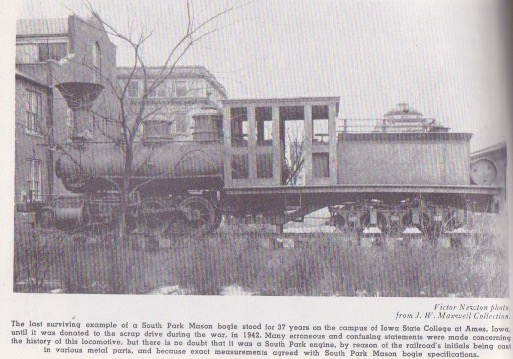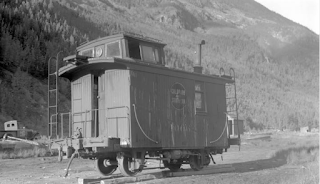I know I should be thankful that we have 5 very
well-preserved locomotives of the C&S.
And I am! Goodness, there are
some railroads with no saved engines.
But one can't help thinking of what might have been. In my readings and research over the years
I've noticed that there were a few other engines that came close to being
saved, but for various reasons were lost.
The next few posts will explore these.
The first lost loco did not make it to the C&S era. In fact, it was a Mason Bogie. Yes, a Mason Bogie from the South Park was
actually preserved! Unfortunately, how
it got saved is a complete mystery. In
fact, which locomotive it was is a mystery as well.
So, here's the story.
According to an article of his in the 1948 Railway and
Locomotive Historical Society Bulletin, Mac Poor, author of the renowned
DSP&P book, was doing some research on locomotives and discovered that
there was "an old bogie type engine" on display at Iowa State
College since roughly 1905. He found some info on the
engine in a school publication listing the various railroads that had at one
time owned this engine. No mention of
the South Park was found there.
However, upon inspection it was found that "The drive
wheel diameters, wheel base, firebox dimensions, gauge and valve gear coincides
exactly with the specifications of Mason engines built for the South
Park."
The real giveaway came when the a "D.S.P" was
found on the casting of the right hand cylinder. In addition to this, "Cast in a front
wheel truck are the words 'Denver Wheel G.W. Co. Denver, Colo. Jan. 14, 1896
U.P.D.&G.'"
So, what happened to it?
Alas, World War II happened.
According to The Pictorial Supplement to the DSP&P, which has a
photo of the loco on display in a somewhat deteriorated condition, the engine was lost
to the wartime scrap drive in 1942.
The caption there reads "The last surviving example of a South Park Mason bogie stood for 37 years on the campus of Iowa State College....Many erroneous and confusing statements were made concerning the history of this locomotive, but there is no doubt that it was a South Park engine."
-->
Side note: Mac Poor's article was published in 1948, but he
makes no mention of the engine being scrapped even though, if The Pictorial
Supplement is correct, the locomotive was gone already for six years.




